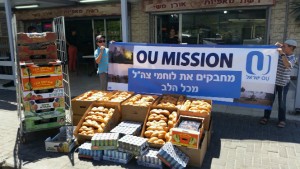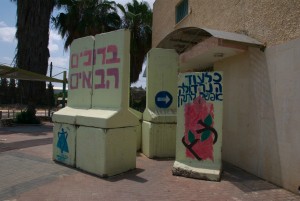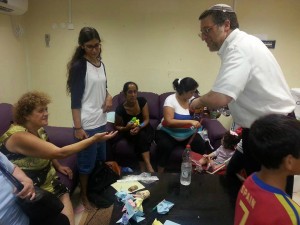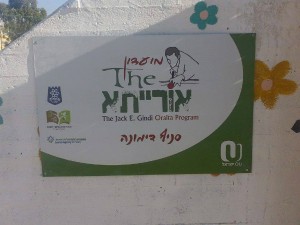Thursday, July 24
Chavi and I arrived on El Al. The flight was full, and the landing was fine and secure, baruch Hashem.
Friday, July 25
 We went to OU Israel, where there were several people waiting to go on the mission. Rabbi Avi Berman (OU Israel Executive Director), a young woman named Dikla who came from Masa Yehudi who was our assigned to be our guide, and Yoel, who was in charge of our security. From there we picked up the mission group at Ben Gurion Airport–and what an impressive group of 45+ people it was. Among those present, aside from Rabbis Weil and myself, were Rabbis Shmidman of the Lower Merion Synagogue, PA; Avraham Steinberg of the Young Israel of Main Line, PA; Rabbi Oppenheimer of the Young Israel of Forest Hills, Queens, NY; Yaakov Vann of Calabasas, CA; Richard Landy of the Community Outreach Center of Monsey, NY; Nissan Antine of Beth Shalom in Potomac , MD; Barry Kornblau of the RCA and of the Young Israel of Hollis Hills-Windsor Park, Queens, NY; along with many other prominent men and women, and even two young single college-aged students—one active in JLIC in the University of Maryland, and the other who came on her own.
We went to OU Israel, where there were several people waiting to go on the mission. Rabbi Avi Berman (OU Israel Executive Director), a young woman named Dikla who came from Masa Yehudi who was our assigned to be our guide, and Yoel, who was in charge of our security. From there we picked up the mission group at Ben Gurion Airport–and what an impressive group of 45+ people it was. Among those present, aside from Rabbis Weil and myself, were Rabbis Shmidman of the Lower Merion Synagogue, PA; Avraham Steinberg of the Young Israel of Main Line, PA; Rabbi Oppenheimer of the Young Israel of Forest Hills, Queens, NY; Yaakov Vann of Calabasas, CA; Richard Landy of the Community Outreach Center of Monsey, NY; Nissan Antine of Beth Shalom in Potomac , MD; Barry Kornblau of the RCA and of the Young Israel of Hollis Hills-Windsor Park, Queens, NY; along with many other prominent men and women, and even two young single college-aged students—one active in JLIC in the University of Maryland, and the other who came on her own.
We headed south towards Sderot from the airport. We stopped at various staging areas and met with soldiers there. Some were returning from Gaza, and others were preparing to enter Gaza. We had all sorts of generously donated food, materials, and supplies with us that we distributed to them.
 In speaking to the soldiers, we learned that they oppose the various ceasefire requests—they wish to remain in Gaza until they get the job done. Some of these soldiers have been involved in demolishing tunnels. They described the tunnels to us as, in some cases, quite vast and very well supplied with food, ammunition, and Israeli army uniforms. They estimate that it takes three to four days to properly demolish a tunnel. There was an attack from a tunnel that opened up near Sderot with ten or more Hamasniks entering Israel proper. This invasion was thwarted, but at the cost of several Israeli soldiers.
In speaking to the soldiers, we learned that they oppose the various ceasefire requests—they wish to remain in Gaza until they get the job done. Some of these soldiers have been involved in demolishing tunnels. They described the tunnels to us as, in some cases, quite vast and very well supplied with food, ammunition, and Israeli army uniforms. They estimate that it takes three to four days to properly demolish a tunnel. There was an attack from a tunnel that opened up near Sderot with ten or more Hamasniks entering Israel proper. This invasion was thwarted, but at the cost of several Israeli soldiers.
The experience of meeting with the soldiers was very moving and poignant, and the achdut was palpable. Gerrer chassidim from Ashdod were distributing Shabbat food to the soldiers in the staging areas.
We then proceeded towards Sderot and visited the Iron Dome facility just outside Sderot. I found it quaint to see that right next to the Iron Dome, the epitome of high-tech, was the lechi to the eruv, which couldn’t possibly be more primitive!
From there, we went to a yeshiva dormitory—which was reinforced so that we were safe from rocket attacks—where we stayed for Shabbat.
On Friday afternoon, we were greeted by Rabbi David Fendel, the Rosh Yeshiva of the yeshivat hesder there, and who is a force for the morale of the entire Sderot community. He has committed to having his yeshiva in Sderot under all circumstances. On Friday night, we ate at the yeshiva, and on Shabbat day, we dined with local families.
Motza’ei Shabbat, July 26
 First of all, we are all safe and on the bus back to Yerushalayim. The Shabbat was amazing, uplifting and inspiring. There were no sirens in Sderot, but Israeli bombs were falling in Gaza every several minutes, all night long. At about 7:00 AM on the way to shul, I heard unearthly explosions and saw columns of smoke in the west where Gaza is. Then, at 8:00 AM, all was quiet. That’s how we knew about that ceasefire.
First of all, we are all safe and on the bus back to Yerushalayim. The Shabbat was amazing, uplifting and inspiring. There were no sirens in Sderot, but Israeli bombs were falling in Gaza every several minutes, all night long. At about 7:00 AM on the way to shul, I heard unearthly explosions and saw columns of smoke in the west where Gaza is. Then, at 8:00 AM, all was quiet. That’s how we knew about that ceasefire.
Rabbi Berman and his staff did an impressive job with arrangements. The rabbi of Tsfat, Rabbi Shmuel Eliyahu, was also a guest of the yeshiva for Shabbat. This yeshiva has unbelievable ruach and is a valuable morale force for the entire community. Six hundred soldiers, mostly from the Gefen Brigade, were camped out on the yeshiva grounds. The soldiers were an impressive cross section of Israeli society, but they all merged well into the yeshiva atmosphere.
Rabbi Weil gave a well-received shiur to our group on Shabbat afternoon, and I spoke to the entire assembly (in Ivrit) on Friday night. Kabbalat Shabbat was a highlight, with singing and dancing. Our group fanned out across the city for morning davening and lunch with private families.
On Shabbat morning, I confess to having left the shul to watch about four hundred of the soldiers store their personal gear in the yeshiva and don their war gear to enter the combat zone—a mere two kilometers from the yeshiva. The soldiers do not talk about their experiences in action, but in light of the news, I must mention that we heard direct instructions given to soldiers about avoiding harm to civilians.
The group went to the roof of the yeshiva where Rabbi Fendel gave a talk. On the roof, we were able to see so much, including parts of Gaza, Ashkelon, Tel Aviv, and much of the Negev.
Seudah Shlishit was followed by a powerful singing session. Yehi shalom becheileich certainly has a different meaning when sung so incredibly close to the enemy, by six hundred bachurim and six hundred combat soldiers. Rav Eliyahu addressed the bachurim with great poignancy.
Sunday, July 27
 On Sunday morning, our first main stop was at the Barzilai Medical Center in Ashkelon. There, its General Director, Dr. Chezi Levi, addressed us. When first introduced to Dr. Levi as being an OU delegation, he asked, “What’s OU?” (I gave him short form explanation.) Dr. Levi told us much about the hospital, including that it’s not entirely fortified and that it was bombed during the 2012 campaign. In response to that, some of its facilities were transferred and fortifications of different areas of the hospital had begun—but it’s still only partially fortified today.
On Sunday morning, our first main stop was at the Barzilai Medical Center in Ashkelon. There, its General Director, Dr. Chezi Levi, addressed us. When first introduced to Dr. Levi as being an OU delegation, he asked, “What’s OU?” (I gave him short form explanation.) Dr. Levi told us much about the hospital, including that it’s not entirely fortified and that it was bombed during the 2012 campaign. In response to that, some of its facilities were transferred and fortifications of different areas of the hospital had begun—but it’s still only partially fortified today.
Dr. Levi then told us a story about a man, a civilian, who was in his apartment in 2012, and there was a rocket that blew up his building. He was brought in with his leg blown off and was almost given up for dead. His family was utterly shocked, and Dr. Levi’s team dealt with them therapeutically. The man’s leg was amputated, they did several surgeries, he recuperated from his wounds, he went through rehabilitation, and he went back to work as a tractor driver. He used this story to illustrate the spirit of his hospital under fire. Dr. Levi then introduced that very victim, now healed. This man now goes from one wounded soldier to another, telling them that there is life after such injuries. Dr. Levi stressed the importance of immediately beginning rehabilitation. He also stressed the importance of treating the soul: he and his devoted staff treat the physically wounded as well as anxiety and post-traumatic stress disorders. He said that they live by the Rambam’s oath, “We treat our enemies, because the science of medicine knows no borders.” He insisted that we tell the world that Israel declared this war after thirteen years of daily rocket attacks. He also pointed out that they are currently treating two wounded Hamas terrorists. Finally, he concluded by praising his staff, which “works with love despite the emotional cost.”
Following Dr. Levi’s introduction, we spent about an hour visiting wounded soldiers.
We saw soldiers in various conditions of severity. One dramatic success is a soldier that was there for week—he was shot in the jaw, he immediately received reconstructive surgery, and he is now eating solid food! We thanked the soldiers, explaining that we came on behalf of hundreds of shuls that are all with them in unity. We davened with them for their refuah shelemah and left them with small gifts. In some cases, we had the opportunity to meet their parents and friends. Many asked me for a berachah. I guess I look like a rabbi even though I was just in shirtsleeves. They served us refreshments, all mehadrin.
From Ashkelon, we drove to Be’er Sheva. As we drove up to the Soroka Medical Center in Be’er Sheva, we were quite impressed by how many Arab patients were there with their families, and how many just stopped what they were doing to pray, right outside on the lawn.
The Soroka Hospital is a much larger, more comprehensive treatment facility than Ashkelon. This hospital is a mere seven-minute helicopter flight from the Gaza front. Generally, the more seriously wounded are flown here. We heard from the hospital director all about the hospital’s history and the scope of its treatment programs in great detail. I have written notes of the details of his talk. There were, at that point, 38 wounded soldiers there, more seriously injured than the ones we had seen in Ashkelon. The hospital’s doctors and staff are now on twelve-hour shifts (as opposed to the typical eight-hour shifts). He especially praised his team of social workers. We visited soldiers who had a range of wounds. The soldiers and their families were extremely appreciative that we came. Once again, I was asked to give berachot, as if I was a rebbe.
While at the hospital, we met MK Dr. Aliza Lavie, who was also there visiting the wounded. And, we met a grandmother of three active soldiers now in Gaza.
From the hospital, we proceeded to have lunch in the Be’er Sheva Mall.
From there, we went to Dimona, where OU Israel has a youth program known Oraita. Dimona is a development town of low socio-economic status. We met Rav Turgeman, who is the head of a nucleus of young yeshiva-educated couples who live and do outreach work in Dimona.
We davened Mincha and headed back to Yerushalayim. Most of the mission participants stayed at the Ramada Renaissance hotel. We had dinner there and heard a most inspiring and emotional address by Miriam Peretz. Mrs. Peretz herself is a mother of two fallen soldiers, one who died in Lebanon, and one who died in a previous action in Gaza.
Monday, July 28
We proceeded to Kiryat Malachi, also in the South, and also a target of many years of Hamas rocket attacks. On the bus ride to Kiryat Malachi, Rabbi Berman asked me to tell the group more about the diverse, wide-ranging activities of the OU. I did so by relating my now-famous M&Ms story, in which I succeeded in getting former President George W. Bush to know that the OU is more than just M&Ms and Kashrut(Rabbi Weinreb is preparing a written version of the M&Ms story which will be available on OU.org shortly.
There, we saw Dr. Debbie Gross, OU Israel’s Trauma Team director, in action. OU Israel works closely with Debbie in helping the children of Kiryat Malachi deal with the trauma to which they are exposed. She and her dedicated team work with children as young as three in teaching them how to cope with their fears, terrors and anxieties.
She uses techniques such art, play, music, physical exercise and meditation. We had an opportunity to see her and her team in action and to speak to the children that she was working with.
From Kiryat Malachi, we proceeded to a nearby town called Be’er Tuvia, where the Ben and Jerry’s ice cream factory is located. There, we heard about how a very large factory copes with code red sirens and rocket attacks. We also learned some details about how the business operates and how profitable the business has become in serving Israel as well as exporting to Europe.
Now we come to what was the most disappointing moment in my trip so far. I had to leave to return to Yerushalayim at this point while the rest of the group got to eat free ice cream! The mission continued after the ice cream with a full day of further activity in the South, before returning to Ben Gurion airport in order to head back to the United States.
Fortunately, I was offered a ride back to Yerushalayim by Zvi Volk, a staff writer for OU Communications who is based in Israel. I had a previous commitment to attend and to address a conference sponsored by the Rabbanei Tzohar, a conference for educators and parents. My assigned topic was “Parenting in a Digital Age.” Shifting gears from the solidarity mission to a conference for parents and educators was challenging. I had actually anticipated that the conference might be canceled. But the determination of our people in Israel is to continue life as usual in spite of the very trying circumstances of war. Over a thousand people attended the conference! My component of the program was to address the English-speaking community. I was joined in my presentation by the distinguished Rabbi Yuval Cherlow, the head of Yeshivat Hesder Petach Tikvah and a noted author. I plan to write up my remarks for publication.
This has been a very intense experience, with every minute programmed. Thank God, we are well, safe, busy, emotionally pained, etc. Generally, life goes on as usual throughout this country, although everyone is directly impacted by the war. There is an obvious disconnect between what the media reports and what life seems like in reality. The hospitals we visited during the course of the mission are the sites of genuine heroism. The hotels are not empty but are far from full. Travel on the roads, except for the areas very close to Gaza, is fine, with the usual crazy driving patterns. The mission was well organized, and the people who signed up for it are very varied and very committed.
The words of this author reflect his/her own opinions and do not necessarily represent the official position of the Orthodox Union.